There are many types of gliding possums, from tiny feathertail gliders that are the size of a small mouse to the almost cat-sized greater gliders. Five gliding possum species live in New South Wales.
Gliding possum species
Feathertail glider
Feathertail gliders (Acrobates pygmaeus) are small, measuring between 6.5 cm and 8 cm in length from head to body. They are mouse-shaped and have grey-brown fur on the back and a white underbelly.
The distinctive tail is quill-like and hairless, except for a fringe of long stiff hairs down either side that resemble a feather. Their tail is about 7 to 8 cm long.
Feathertail gliders only weigh between 10 and 15 grams.
Their gliding membrane extends from elbow to knee and is thicker than other glider species.
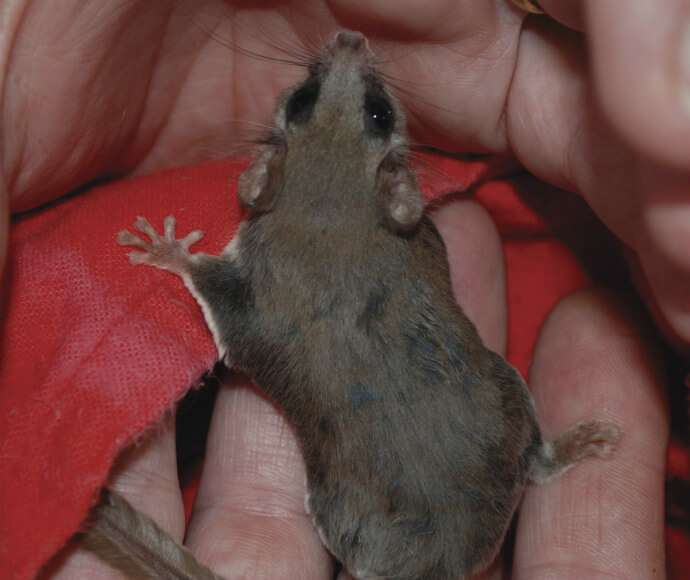
Feathertail gliders (Acrobates pygmaeus) are known as pygmy gliding possums.
Greater glider
The greater glider (Petauroides volans) is the largest gliding possum, with a head and body length of 35 to 45 cm and a long furry tail measuring 45 to 60 cm.
The greater glider has thick fur that increases its apparent size. Fur colour is white or cream below and varies from dark grey, dusky brown through to light mottled grey and cream above.
It has large ears and strongly reflective eyeshine in the beam of a spotlight, making it easy to detect.
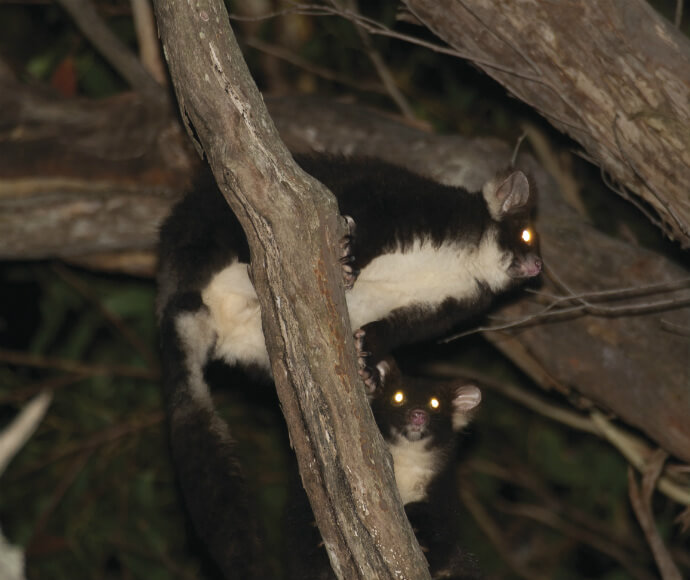
Greater gliders (Petauroides volans) have large ears and strongly reflective eyeshine.
Squirrel glider
Adult squirrel gliders (Petaurus norfolcensis) have a head and body length of about 20 cm. They have blue-grey to brown-grey fur above, white on the belly and the end third of the tail is black.
There is a dark stripe from between the eyes to the mid-back and the tail is soft and bushy, averaging about 27 cm long.
Squirrel gliders are up to twice the size of sugar gliders, and their facial markings are more distinct.
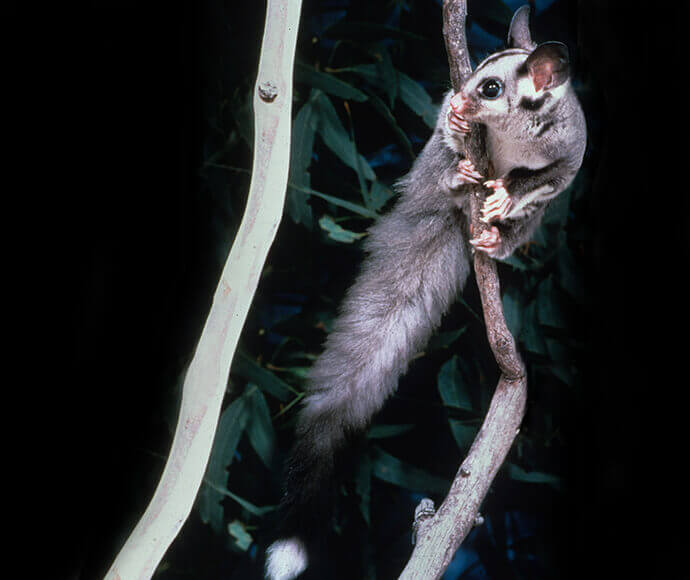
Squirrel gliders (Petaurus norfolcensis) are up to twice the size of sugar gliders.
Sugar glider
The sugar glider’s (Petaurus breviceps) fur is a blue-grey to brown-grey, with a dark stripe that extends from the middle of the head to the mid-back region.
They are about the size of a rat, with adults weighing between 100 to 160 grams. They have a round face and their tail is thick and may have a white tip.
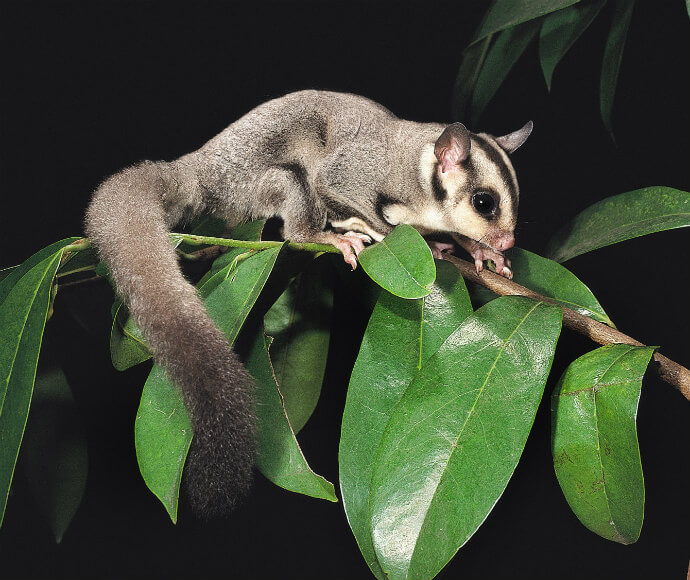
Sugar gliders (Petaurus breviceps) are about the size of rats.
Yellow-bellied glider
The yellow-bellied glider (Petaurus australis) is a large, active, sociable and vocal glider. Adults weigh from 450 to 700 grams, have a head and body length of about 30 cm and a large bushy tail that is about 45 cm long.
The glider has grey to brown fur above with a cream to yellow belly, which is paler in young animals. The dark stripe down the back is characteristic of the group.
It has a large gliding membrane that extends from the wrist to the ankle.
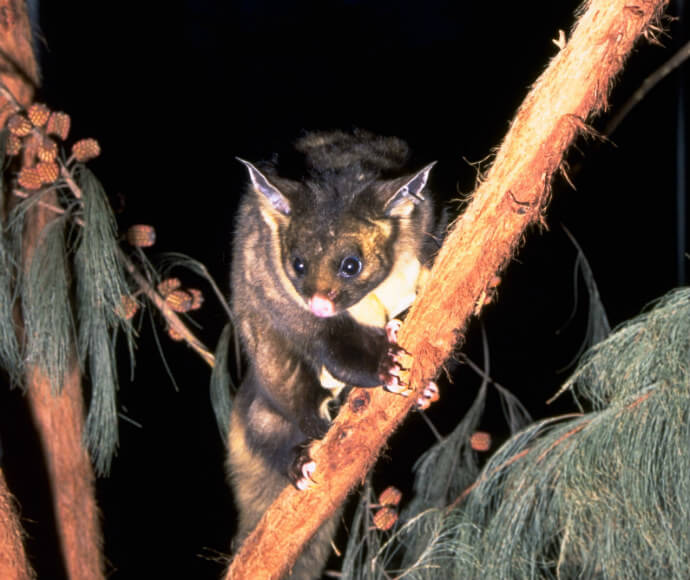
Yellow-bellied gliders (Petaurus australis) have a characteristic dark stripe down their backs.
How do they glide?
A gliding possum has a 'gliding membrane' – a thin sheet of skin which stretches between its forepaws and its ankles. When it leaps from a branch, its outspread limbs extend the membrane, allowing the animal to glide from tree to tree.
At first the leap is downwards but, as the animal increases speed, the angle of flight flattens out. With its long, well-furred tail acting as a rudder, the glider can steer towards its next tree.
Then, just before landing, it uses its tail to bring it into a 'nose up' position (much like an aircraft landing). Feet stretched out in front, it is ready to grasp the tree trunk and land.
The yellow-bellied glider can cover distances of up to 140 metres in one leap. The sugar glider and squirrel glider can reach about 50 metres.
Where do they live?
Gliders generally live in a wide variety of eucalypt forests, most of which line the east coast and ranges of Australia. Sugar gliders have the widest distribution, as they can stand a greater variation in climate than the other species.
They can be found in many different habitats, from the tropical parts of the Northern Territory to the cooler areas of Tasmania. Yellow-bellied gliders, on the other hand, are restricted to rich forest ecosystems that provide a continual supply of food.
Gliders usually make their nests in tree hollows, which they line with dry leaves. Some species, particularly the greater glider, mark out their territory by using scent glands. They rub the gland against the trees to warn off intruders.
What do they eat?
Gliders feed at night. Their diet includes nectar, pollen, insects and the sap of certain eucalypt or wattle trees (in collecting eucalypt sap, yellow-bellied gliders leave distinctive V-shaped notches on trees). The greater glider, however, feeds almost entirely on eucalypt leaves.
Breeding and life cycle
The greater glider is the only gliding possum that does not live in a family or social group. These animals only come together for mating, and usually only one young glider is born. Other gliders have one or two at a time, although the feathertail glider can have a litter of up to 4.
A naked, newborn glider (also called a neonate – a term which applies to all newborn marsupials) would fit on your thumbnail. Following birth, it crawls through its mother's fur to her pouch, where it attaches itself to a teat. Here it is kept warm and nourished with milk. After about 3 or 4 months it will come out into the nest and, with the adults, search for food.
When the young are big enough to look after themselves, they will usually leave the family and set up a group or territory of their own. Some females may stay with the original group, but males are often forced to leave.
Threats
Gliders are protected in New South Wales. The squirrel glider and the yellow-bellied glider are quite uncommon. They have been listed as vulnerable under the Biodiversity Conservation Act 2016 and are in need of special protection.
The greatest threat to gliders comes from the destruction and alteration of the forest habitats in which they live. Gliders need mature forests with lots of tree hollows to nest in. When forests are cleared they lose their home and food supply, and may become prey to other species such as owls, foxes and cats. The gliders are easy targets in cleared or open areas.
Protection of native animals
All native birds, reptiles, amphibians and mammals, but not including dingoes, are protected in New South Wales by the Biodiversity Conservation Act 2016.